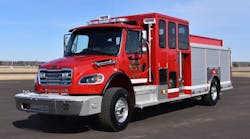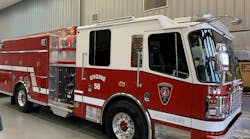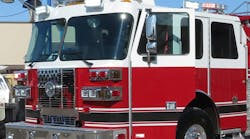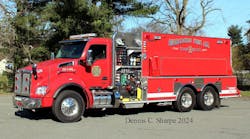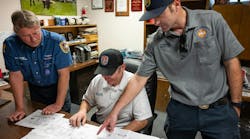Pumps Refresher Course
Session Reference:1
Topic:Review of Hydraulics and Pump Components
Time Required: 3 hours
Materials:Chalkboard
Reference:Pump Operator Student Manual, Maryland Fire and Rescue Institute
Preparation:
Motivation:
Objective (SPO): 1-1
The student will demonstrate a basic understanding of fluid hydraulics, centrifugal pump components, and fireground hydraulics through class discussion and participation.
Overview:
Review of Hydraulics and Pump Components
* Introduction to Fluids
* Centrifugal Pump Components
* Hydraulics Review
Session 1 Review Of Hydraulics And Pump Components
SPO 1-1 The student will demonstrate a basic understanding of fluid hydraulics, centrifugal pump components, and fireground hydraulics through class discussion and participation.
1 - 1 Demonstrate an understanding of basic fluid hydraulics as they relate to the operation of a pump on motorized fire apparatus.
1 - 2 Demonstrate an understanding of the purpose and operation of the various components of a centrifugal pump on motorized fire apparatus.
1 - 3 Demonstrate an understanding of nozzle pressure, friction loss, and the calculation of water to produce adequate fire streams.
The Pumps Refresher course is designed for individuals who are currently or have been pump operators and who have successfully completed a pumps course. There should be a lot of interaction rather than lecture.
I . Introduction to Fluids (1-1)
A. Water is incompressible
B. Components affecting movement of water
1. Flow (GPM)
2. Pressure (PSI)
3. Resistance (FL)
C. Basic principles of water
1. A column of water one foot high exerts .434 PSI at the base/.434 PSI required to lift column of
water one foot (rounded to .5 PSI per foot)
2. A column of water 2.304 feet high produces 1 PSI at the base/1 PSI is required to lift a column of
water 2.304 feet
3. 1 gallon of water weights 8.35 lbs.
4. 1 cubic foot of water contains 7.5 gallons and weights 62.5 lbs.
D. Nozzle restricts flow of water thereby creating pressure at tip
II. Centrifugal Pump Components (1-2)
A. Power Train
1. Pump shift - initiates transfers power from road transmission to pump transmission
2. Transfer case - location of gears to change engine power from road operations to pump operations
3. Pump shaft - shaft on which pump impellers ride
B. Pump Housing
1. Impeller(s) - number dependent on number of stages
2. Casing - houses impeller(s) and controls flow of water
3. Clearance rings - seal between impeller(s) and casing
4. Packing - provides seal where shaft passes through casing
5. Transfer valve - changes flow of water in casing on multi-stage pumps
C. Pump Panel Controls
1. Valves
a. intake - controls incoming water flow
b. discharge - controls outgoing water flow
c. pressure/volume or series/parallel – operates transfer valve on multi-stage pumps
d. bleeder - relieves pressure on intakes or discharges
e. drain - allows water to be drained from pump
f. tank to pump - allows water to flow from booster tank to pump
g. tank fill - allows booster tank to be filled through pump
2. Pressure control
a. relief valve - dumps excess pressure back into intake side of pump
b. pressure governor – controls pressure by reducing engine speed
c. intake relief - dumps excess on intake side of pump to ground
3. Gauges
a. intake - registers intake pressure from pressurized sources
b. discharge - registers discharge pressure on lines charged
1 ) master - registers highest discharge pressure
2 ) individual – registers discharge pressure for individual lines
c. tachometer - registers engine speed
d. oil pressure - registers engine oil pressure
e. water level - registers water level in booster tank
f. temperature - registers engine temperature
4. Other
a. primer - creates vacuum in casing for drafting operations
b. auxiliary cooler – circulates water between pump and radiator
c. Radiator fill - transfers water from pump to radiator
III . Hydraulics review (1-3)
A. Nozzle pressures
1. Straight tip
a. 50 PSI handlines
b. 80 PSI master streams
2. Fog tip - 100 PSI handlines and master streams
3. Automatic nozzles - 100 PSI handlines
B. Friction loss principles
1. Round flow to nearest 50 gallons
2. Supply lines - based on 3-inch hose (using hand method)
a. 3-inch hose - Q2 (in hundreds of gallons)
b. 4-inch hose - Q2 (in hundreds of gallons) divided by 5
c. 5-inch hose - Q2 (in hundreds of gallons) divided by 15
d. 2-1/2-inch hose - Q2 (in hundreds of gallons) times 2
e. If quantity is between hundreds, multiply lower and upper quantities together. For example, 350
gallons, multiply 3 times 4 for a total of 12 PSI per 100 feet between for 3-inch hose. Convert
for 2-1/2-, 4-, or 5-inch hose.
3. Attack lines up to and including 2-inch, 30 PSI per 100-feet
4. Devices - 10 PSI per device
5. Elevation - .5 PSI per foot
C. Calculating friction loss
1. Attack pumper EP = FL + D +/- EL + NP
2. Supply pumper EP = FL + D +/- EL + 50 PSI
D. Pressure control devices
1. Intake
a. Intake relief valve
b. LDH relief valve
Should be set no more than 20 PSI above the average water system pressure in response area
2. Discharge
a. Pressure governor
b. Relief valve Should be set after lines are charged
E. Characteristics of hose*
Quantity of Water Weight of Water Maximum Flow
(in gal.) (in lbs.) (in GPM)
1-1/2-in. 9.00 75.15 125
1-3/4-in. 12.25 102.29 150
2-in. 16.00 133.60 200
2-1/2-in. 25.00 208.75 250
3-in. 36.00 300.60 400
4-in. 64.00 534.40 800
5-in. 100.00 835.00 1,500
*Quantity and weight based on 100 feet of hose
Review:
Review of Hydraulics and Pump Components
* Introduction to Fluids
* Centrifugal Pump Components
* Hydraulics Review


